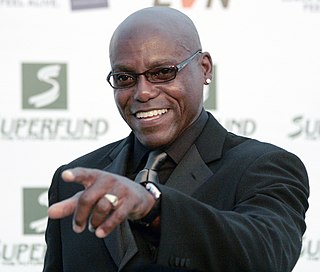
BASE jumping, also sometimes written as B.A.S.E. jumping, is parachuting or wingsuit flying from a fixed structure or cliff. "BASE" is an acronym that stands for four categories of fixed objects from which one can jump: building, antenna, span, and earth (cliff). Due to the lower altitudes of the jumps, BASE jumping is significantly more dangerous than skydiving from a plane. In the U.S., BASE jumping is currently regarded by many as a fringe extreme sport or stunt.

The high jump is a track and field event in which competitors must jump unaided over a horizontal bar placed at measured heights without dislodging it. In its modern most practised format, a bar is placed between two standards with a crash mat for landing. In the modern era, athletes run towards the bar and use the Fosbury Flop method of jumping, leaping head first with their back to the bar. Since ancient times, competitors have introduced increasingly effective techniques to arrive at the current form.

The long jump is a track and field event in which athletes combine speed, strength and agility in an attempt to leap as far as possible from a take off point. Along with the triple jump, the two events that measure jumping for distance as a group are referred to as the "horizontal jumps". This event has a history in the Ancient Olympic Games and has been a modern Olympic event for men since the first Olympics in 1896 and for women since 1948.

Show jumping, also known as "stadium jumping", "open jumping", or simply "jumping", is a part of a group of English riding equestrian events that also includes dressage, eventing, hunters, and equitation. Jumping classes are commonly seen at horse shows throughout the world, including the Olympics. Sometimes shows are limited exclusively to jumpers, sometimes jumper classes are offered in conjunction with other English-style events, and sometimes show jumping is but one division of very large, all-breed competitions that include a very wide variety of disciplines. Jumping classes may be governed by various national horse show sanctioning organizations, such as the United States Equestrian Federation in the USA or the British Showjumping Association in Great Britain. International competitions are governed by the rules of the International Federation for Equestrian Sports.

Ski jumping is a winter sport in which competitors aim to achieve the longest jump after descending from a specially designed ramp on their skis. Along with jump length, competitor's style and other factors affect the final score. Ski jumping was first contested in Norway in the late 19th century, and later spread through Europe and North America in the early 20th century. Along with cross-country skiing, it constitutes the traditional group of Nordic skiing disciplines.

Bungee jumping is an activity that involves jumping from a tall structure while connected to a large elastic cord. The tall structure is usually a fixed object, such as a building, bridge or crane; but it is also possible to jump from a movable object, such as a hot-air-balloon or helicopter, that has the ability to hover above the ground. The thrill comes from the free-falling and the rebound. When the person jumps, the cord stretches and the jumper flies upwards again as the cord recoils, and continues to oscillate up and down until all the kinetic energy is dissipated.

Robert Craig Knievel Jr., professionally known as Evel Knievel, was an American stunt performer and entertainer. Over the course of his career, he attempted more than 75 ramp-to-ramp motorcycle jumps; in 1974, he failed an attempted canyon jump across Snake River Canyon in the Skycycle X-2, a steam-powered rocket.

Frederick Carlton "Carl" Lewis is an American former track and field athlete who won nine Olympic gold medals, one Olympic silver medal, and 10 World Championships medals, including eight gold. His career spanned from 1979 to 1996, when he last won an Olympic event. He is one of only three Olympic athletes who won a gold medal in the same individual event in four consecutive Olympic Games.

Jumping the shark is the moment when something that was once popular that no longer warrants the attention it previously received makes an attempt at publicity which only serves to highlight its irrelevance. This is especially applicable to television series or other entertainment outlets.

Track and field is a sport which includes athletic contests established on the skills of running, jumping, and throwing. The name is derived from the sport's typical venue: a stadium with an oval running track enclosing a grass field where the throwing and some of the jumping events take place. Track and field is categorized under the umbrella sport of athletics, which also includes road running, cross country running, and race walking.

Seinen manga (青年漫画) are manga marketed toward young adult men. In Japanese, the word "seinen" literally means "youth," but the term "seinen manga" is also used to describe the target audience of comics like Weekly Manga Times and Weekly Manga Goraku which are aimed at men from their 20s to their 50s. Seinen manga are distinguished from shōnen manga which are for younger boys, although some seinen manga like xxxHolic share some similarities with "shōnen" manga. Seinen manga can focus on action, politics, science fiction, fantasy, relationships, sports, or comedy. The female equivalent to seinen manga is josei manga.

Jumping spiders are a group of spiders that constitute the family Salticidae. As at 1 February 2019, this family contained 636 described genera and 6115 described species, making it the largest family of spiders at 13% of all species. Jumping spiders have some of the best vision among arthropods and use it in courtship, hunting, and navigation. Although they normally move unobtrusively and fairly slowly, most species are capable of very agile jumps, notably when hunting, but sometimes in response to sudden threats or crossing long gaps. Both their book lungs and tracheal system are well-developed, and they use both systems. Jumping spiders are generally recognized by their eye pattern. All jumping spiders have four pairs of eyes, with the anterior median pair being particularly large.

Weekly Shōnen Jump is a weekly shōnen manga anthology published in Japan by Shueisha under the Jump line of magazines. It is the best-selling manga magazine, as well as one of the longest-running; the first issue was released with a cover date of August 1, 1968. The manga series within the magazine target young male readers and tend to consist of a large number of action scenes and a fair amount of comedy. The chapters of series that run in Weekly Shōnen Jump are collected and published in tankōbon volumes under the "Jump Comics" imprint every two to three months.

The standing long jump, also known as the standing broad jump, is an athletics event. It was an Olympic event until 1912. It is one of three standing variants of track and field jumping events, which also include the standing high jump and standing triple jump.

The FIS Nordic World Ski Championships is a biannial nordic skiing event organized by the International Ski Federation (FIS). The World Championships was started in 1925 for men and opened for women's participation in 1954. World Championship events include nordic skiing's three disciplines: cross-country skiing, ski jumping, and nordic combined. From 1924 to 1939, the World Championships were held every year, including the Winter Olympics. After World War II, the World Championships were held every four years from 1950 to 1982. Since 1985, the World Championships have been held in odd-numbered years.
A vertical jump or vertical leap is the act of raising one's center of mass higher in the vertical plane solely with the use of one's own muscles; it is a measure of how high an individual or athlete can elevate off the ground (jump) from a standstill. Daniel Kabeya has the highest vertical jump ever recorded.

J-Stars Victory VS is a crossover fighting video game that combines the universes of several Weekly Shōnen Jump manga series, including former series and some that have been transferred to other magazines. It was released in Japan by Bandai Namco Entertainment on March 19, 2014 for the PlayStation 3 and PlayStation Vita in celebration of Weekly Shōnen Jump's 45th anniversary. It was re-released for western territories as J-Stars Victory VS+ for the PlayStation 4, PlayStation 3, and PlayStation Vita, with an additional Arcade Mode for the international release. It was released in Europe on June 26, 2015 and in North America on June 30, 2015. A follow-up game, Jump Force, released on February 15, 2019 to tie in with the 50th anniversary of Weekly Shōnen Jump.

Black Clover is a Japanese manga series written and illustrated by Yūki Tabata. It has been serialized in Shueisha's Weekly Shōnen Jump magazine since February 16, 2015, and has been collected into 19 tankōbon volumes. The story centers around Asta, a young boy seemingly born without any magic power, something that is unknown in the world he lives in. With his fellow mages from the Black Bulls, Asta plans to become the next Wizard King.

Jump Force is a crossover fighting game developed by Spike Chunsoft and published by Bandai Namco Entertainment featuring characters from various manga series featured in Shueisha's Weekly Shōnen Jump anthology in celebration of the magazine's 50th anniversary. The game was released on February 15, 2019 for Windows, PlayStation 4, and Xbox One.



















